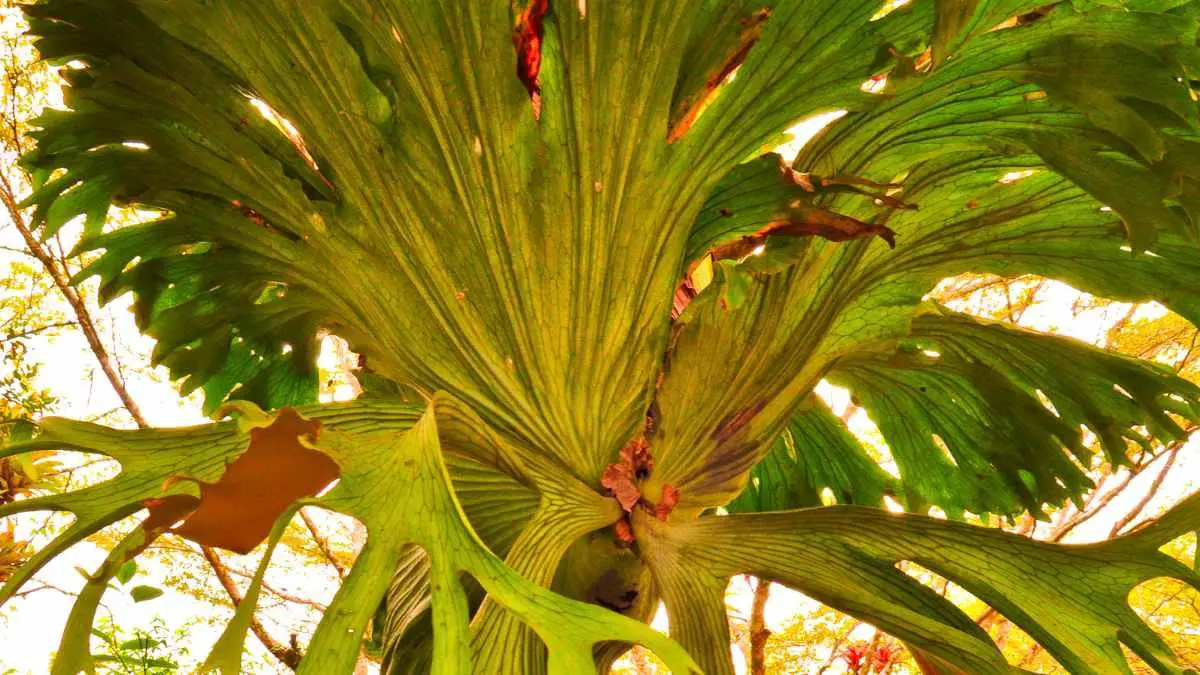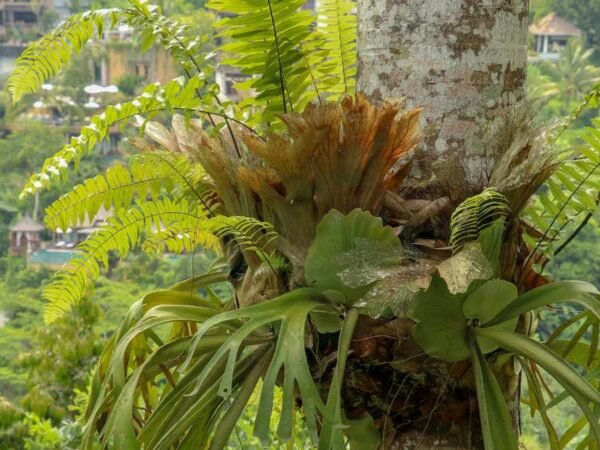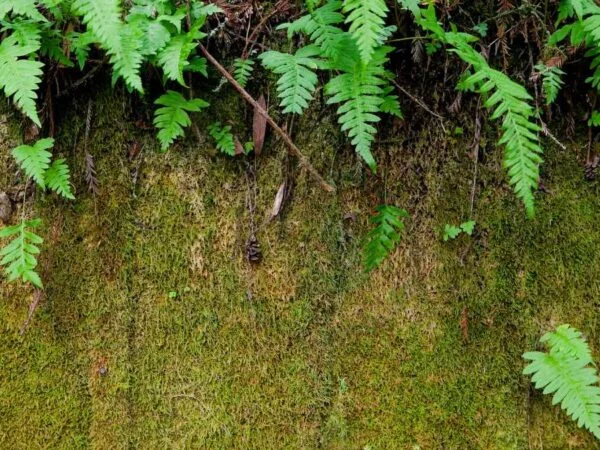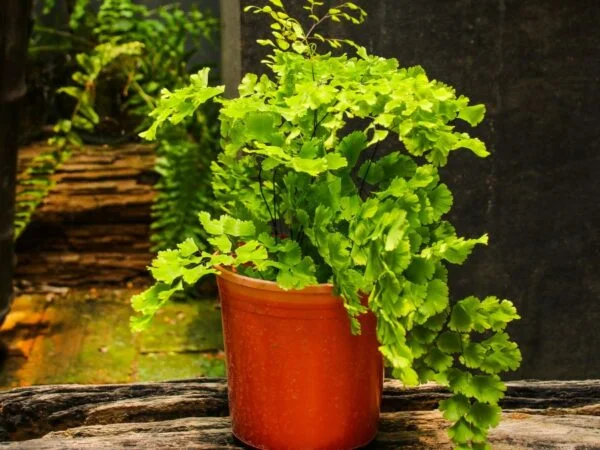Are you wondering how to grow Staghorn Fern successfully? Don't worry, I've got you covered with expert tips and guidance!
Staghorn Ferns (Platycerium spp.) are fascinating epiphytic plants known for their distinctive antler-like fronds. To grow these unique epiphytic ferns with foliar fronds, start by selecting a suitable mounting surface such as a wooden board or a wire basket filled with sphagnum moss as a medium. Attach the fern securely to the chosen surface using twine or wire, ensuring good contact between the plant and the mount, especially during the cool season. Place your Staghorn Fern in a location with bright, indirect light and maintain a humid environment by misting the plant regularly.
Water your fern by thoroughly soaking the root ball, allowing excess water to drain away to prevent rot. Fertilize monthly during the growing season with a balanced liquid fertilizer diluted to half strength. With proper care and attention, your Staghorn Fern will thrive and become a stunning focal point in your home or garden.
Ready to dive deeper into the world of Staghorn Ferns? Discover advanced techniques for propagation, troubleshooting common issues, and creative display ideas to showcase your growing collection of these captivating plants. Whether you're a beginner or an experienced fern enthusiast, there's always more to learn and explore on your journey to mastering the art of Staghorn Fern cultivation.
Key Takeaways
- Consistent Care: Regularly water your staghorn fern, provide adequate lighting, and feed it to promote healthy growth.
- Propagate with Care: Utilize staghorn fern propagation techniques to expand your plant collection.
- Troubleshooting Tips: Address common issues like yellowing leaves or pests promptly to maintain a thriving staghorn fern.
- Preventative Measures: Take steps to prevent diseases and pests by maintaining proper care practices and monitoring your plant regularly.
- Regular Maintenance: Follow care and maintenance tips to ensure your staghorn fern remains vibrant and flourishing.
- Quality Sources: When purchasing staghorn ferns, choose reputable sellers to acquire healthy plants for your collection.
Staghorn Fern Basics
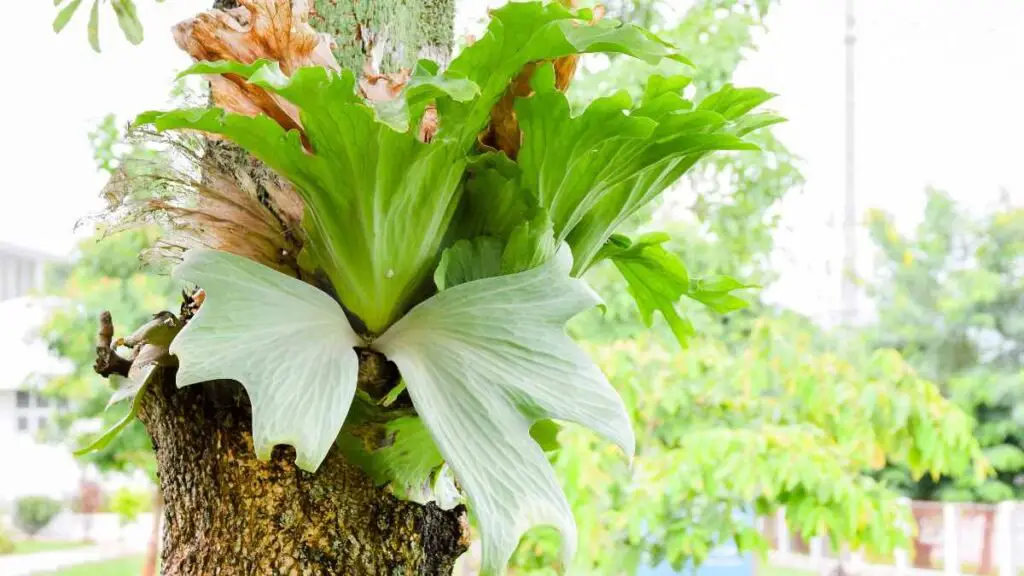
Understanding Staghorn Ferns
Staghorn ferns are epiphytic plants known for their unique appearance resembling stag horns. They absorb moisture and nutrients through their fronds, not roots. Growing trends include mounting them on wooden planks for decorative displays.
Ideal Growing Conditions
Lighting Needs
- Staghorn ferns thrive in bright, indirect light, making them perfect for shaded areas.
- Direct sunlight can damage their fronds, so it's crucial to shield them from harsh rays.
- When temperatures dip below 60 degrees Fahrenheit, consider moving them indoors for warmth.
Temperature and Humidity
- Staghorn ferns prefer temperatures between 60 to 80 degrees Fahrenheit for optimal growth.
- Humidity levels impact watering frequency; higher humidity means less frequent watering.
- As the weather cools, bring your staghorn ferns indoors to protect them from chilly temperatures.
Soil and Mounting Essentials
To create a suitable environment for staghorn ferns:
- Use a well-draining mix of peat moss, perlite, and orchid bark for the soil.
- Mounting staghorn ferns involves securing the root ball onto a wooden plank with sphagnum moss.
- Alternatively, consider hanging baskets as another mounting option to display these unique plants.
Watering Staghorn Ferns
Watering Techniques
Staghorn ferns absorb water through both their roots and fronds, requiring a balance for optimal growth. Proper drainage is crucial to prevent root rot, ensuring the plant's health. Utilizing Moisture Meters can aid in determining the ideal watering frequency, preventing over or under watering.
Frequency Tips
For watering frequency, a general rule of thumb is to increase watering during warmer seasons and reduce it during colder months. Adjusting watering schedules based on specific growing conditions such as humidity levels is essential. Watch out for signs of overwatering like yellowing fronds and underwatering such as dry, crispy leaves.
Lighting for Staghorn Ferns
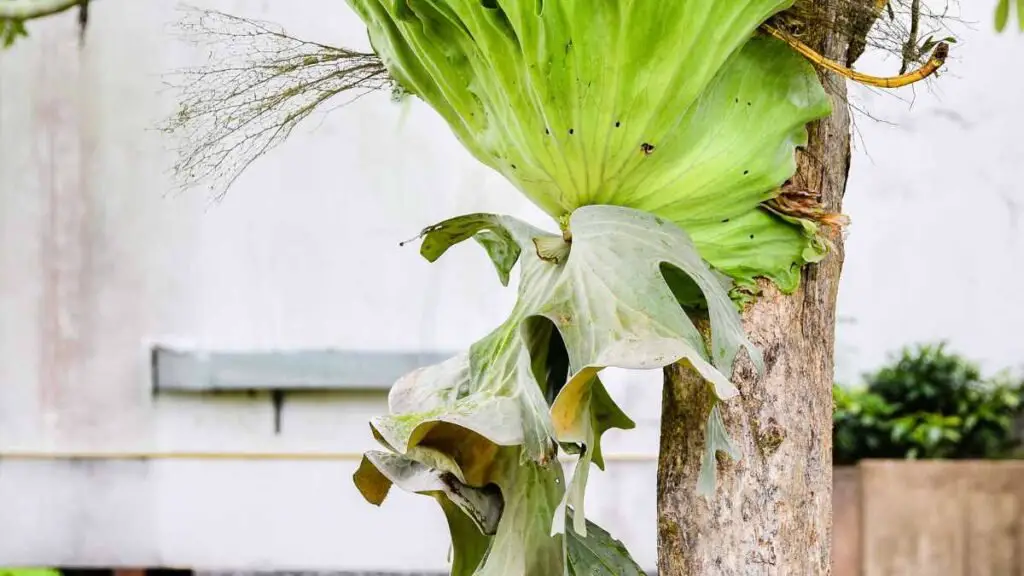
Light Requirements
Staghorn ferns prefer bright, indirect light to thrive and grow healthily. Direct sunlight should be avoided as it can scorch their leaves, leading to damage. Good drainage is essential in relation to lighting to prevent waterlogged soil, which can harm the plant.
Positioning Your Fern
Position your staghorn fern where it can receive adequate light for optimal growth. When transitioning from outdoor to indoor settings based on temperature changes, ensure that the fern continues to receive proper lighting conditions. Proper positioning is crucial for the fern's overall health and development.
Feeding Your Staghorn Fern
Fertilization Schedule
Feeding your staghorn fern regularly is essential for its growth and development. Regular fertilization provides the necessary nutrients for young ferns to thrive. During the warm growing season, it is ideal to fertilize your fern to support its active growth. Adjusting feeding schedules based on the plant's age is crucial to meet its changing nutritional requirements.
Nutrient Needs
Staghorn ferns have specific nutrient requirements for optimal growth. These include nitrogen, phosphorus, and potassium. Fertilizers play a significant role in providing these essential nutrients to the fern. Monitoring nutrient levels in the soil is vital to ensure that the plant receives adequate nutrition for healthy development.
Staghorn Fern Propagation
Splitting Methods
Splitting staghorn ferns involves dividing the plant into smaller sections to create new individual plants. This method is ideal for rejuvenating overcrowded ferns and promoting healthier growth. To split a staghorn fern, begin by carefully removing it from its pot. Next, identify natural divisions in the plant and gently separate them using a sharp knife or pruning shears.
Splitting benefits staghorn ferns by allowing each new section to develop its root system, enhancing overall plant health. This process also encourages the growth of new fronds, resulting in a fuller and more vibrant appearance. By splitting your staghorn fern, you can propagate multiple healthy plants from a single mature specimen.
- Identify natural divisions in the plant.
- Carefully separate the sections with a sharp tool.
- Plant each divided section in suitable growing medium.
- Ensure adequate moisture and indirect sunlight for optimal growth.
Spore Sowing
ing spores is another effective method for propagating staghorn ferns, especially for expanding your collection. To sow spores, collect mature sporangia from the underside of fertile fronds and place them in a container filled with moist peat moss or sphagnum moss. Over time, these spores will germinate and develop into young ferns.
ing spores benefits fern enthusiasts by offering an alternative way to propagate these unique plants. It allows for the creation of genetically diverse offspring, contributing to the diversity of your staghorn fern collection. As the spores germinate and grow, they gradually form new fronds, establishing themselves as independent plants.
- Collect mature sporangia from fertile fronds.
- Place sporangia in a container with moist moss.
- Keep the container in a warm and humid environment.
- Monitor spore germination progress regularly for successful propagation.
Common Problems and Solutions
Blackening Fronds
Blackening fronds in staghorn ferns can be caused by overwatering or inadequate air circulation. Excessive moisture at the base leads to rot, turning fronds black. To prevent this, ensure proper drainage.
To address blackening fronds, trim affected areas promptly to prevent further spread of disease. Improve ventilation around the plant to promote drying and prevent future issues.
Blackening fronds not only affect the aesthetic appeal but also indicate underlying health concerns. Addressing this promptly is crucial to maintain overall plant vitality.
Wilting Tips
Wilting fronds in staghorn ferns are often a result of underwatering or excessive sunlight exposure. Inadequate watering can lead to dehydration and wilting of the tips.
To prevent wilting, maintain consistent watering schedules and ensure the plant receives adequate but indirect sunlight. If wilting occurs, consider increasing humidity levels around the plant.
Prolonged wilting can significantly impact the plant's vitality by affecting its ability to photosynthesize effectively, leading to stunted growth and reduced resilience.
Brown Shield Management
Brown shield fronds are a natural part of a staghorn fern's growth cycle. These older fronds serve as protective shields for the plant's base and roots from external elements.
To manage brown shield fronds, avoid removing them prematurely, as they provide essential protection. Regularly inspect these fronds for any signs of pests or diseases that may compromise their function.
Shield fronds play a vital role in maintaining plant health by shielding delicate parts from damage and providing structural support for overall growth.
Preventing Pests and Diseases
Identifying Pests
Common pests that can affect staghorn ferns include aphids, mealybugs, and scale insects. These pests feed on the plant sap, causing wilting and yellowing of leaves.
Look out for signs of pest infestation such as sticky residue on leaves, distorted growth, or visible insects. Regularly inspect the undersides of leaves where pests often hide.
To identify and treat pest issues, consider using natural remedies like neem oil or insecticidal soap. Prune affected areas and isolate heavily infested plants to prevent the spread of pests.
Disease Prevention
Implement preventive measures to protect staghorn ferns from diseases by ensuring proper air circulation and avoiding overwatering. Maintain a clean environment by removing dead foliage promptly.
Proper care practices, including providing adequate sunlight and avoiding waterlogged soil, are crucial in disease prevention. Avoid splashing water on leaves to prevent fungal infections.
Common diseases that can affect staghorn ferns include root rot and leaf spot diseases. Monitor your plants regularly for any signs of discoloration or unusual growth patterns.
Care and Maintenance Tips
Regular Check-ups
Regularly inspecting your staghorn fern is crucial for ensuring its health and well-being. These check-ups allow you to detect any issues early on, preventing potential damage. By conducting routine maintenance, you can address problems promptly.
Consistent care includes examining the plant for signs of pests, diseases, or nutrient deficiencies. A thorough checklist for check-ups should include inspecting the fronds, shield fronds, and the overall coloration of the plant. Look out for any unusual spots, discoloration, or wilting.
Seasonal Adjustments
Adapting your care routines based on the seasons is essential for optimal staghorn fern growth. Different seasons bring varying light levels, temperatures, and humidity levels that affect plant development. Adjust watering frequency and fertilization accordingly.
During colder months, reduce watering to prevent root rot due to lower evaporation rates. In contrast, in warmer seasons, increase watering to accommodate higher evaporation rates. Adjust the placement of the plant to ensure it receives adequate sunlight throughout the year.
Where to Buy Staghorn Ferns
Selecting Healthy Plants
When purchasing staghorn ferns at nurseries, look for ones with vibrant green fronds and no signs of yellowing. Check for sturdy root systems and avoid plants with mushy or discolored leaves. Ensure the shield frond is intact and free from damage.
To ensure you are getting a healthy staghorn fern, inspect the plant for any pests like mealybugs or scale insects. Choose a plant that is well-hydrated but not overwatered, as soggy soil can lead to root rot. Opt for specimens with multiple fronds for better growth potential.
Online vs Local Nurseries
Purchasing staghorn ferns from online nurseries offers a wider selection and convenience in browsing different varieties. Online nurseries often provide detailed care instructions and can deliver plants directly to your doorstep. However, there may be risks associated with shipping stress.
Supporting local nurseries when buying staghorn ferns helps sustain small businesses in your community and reduces the environmental impact of long-distance shipping. You can personally inspect the plants before purchase, ensuring you get exactly what you want without any surprises. Consider factors such as cost, availability, and shipping times when deciding between online and local nurseries.
Summary
In caring for your staghorn fern, you've learned the essentials: watering, lighting, feeding, propagation, troubleshooting, and maintenance tips. Remember to keep a close eye on your fern's needs, ensuring proper care to help it thrive. By following these guidelines and being attentive to your plant's requirements, you can enjoy a healthy and vibrant staghorn fern in your living space. Share your newfound knowledge with fellow plant enthusiasts and continue to expand your green thumb skills. Happy gardening!
Frequently Asked Questions
How often should I water my staghorn fern?
Water your staghorn fern once a week during the growing season, and reduce watering to every 2-3 weeks in winter. Ensure the mounting board is dry between waterings to prevent root rot.
Can I place my staghorn fern in direct sunlight?
Staghorn ferns prefer bright, indirect light. Direct sunlight can scorch their fronds. Place them in a location with filtered light or where they receive morning sun and afternoon shade.
What type of fertilizer should I use for my staghorn fern?
Use a balanced liquid fertilizer diluted to half strength. Apply it to the base of the plant's shield fronds every 4-6 weeks during the growing season. Avoid fertilizing in winter when growth slows down.
How can I propagate my staghorn fern?
To propagate your staghorn fern, divide its offsets or pups from the main plant carefully. Mount these divisions onto separate boards or pots with sphagnum moss until they establish roots and grow into new plants.
What are common problems that affect staghorn ferns?
Common issues include overwatering leading to root rot, inadequate light causing pale fronds, and pests like scale insects or mealybugs. Monitor your plant regularly for signs of these problems and take prompt action to address them.
Image Source: Paid image from CANVA

